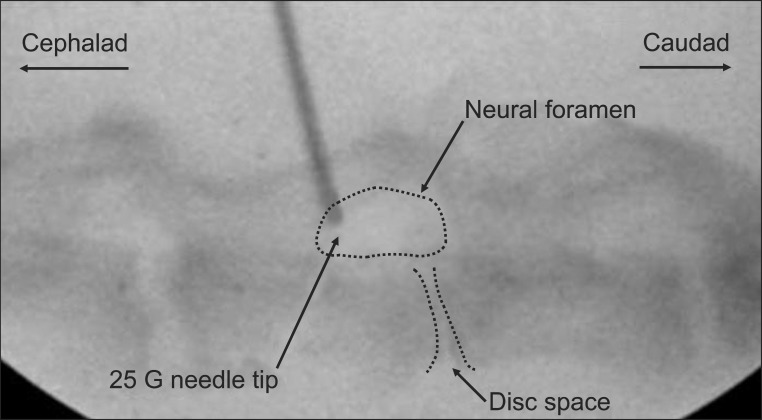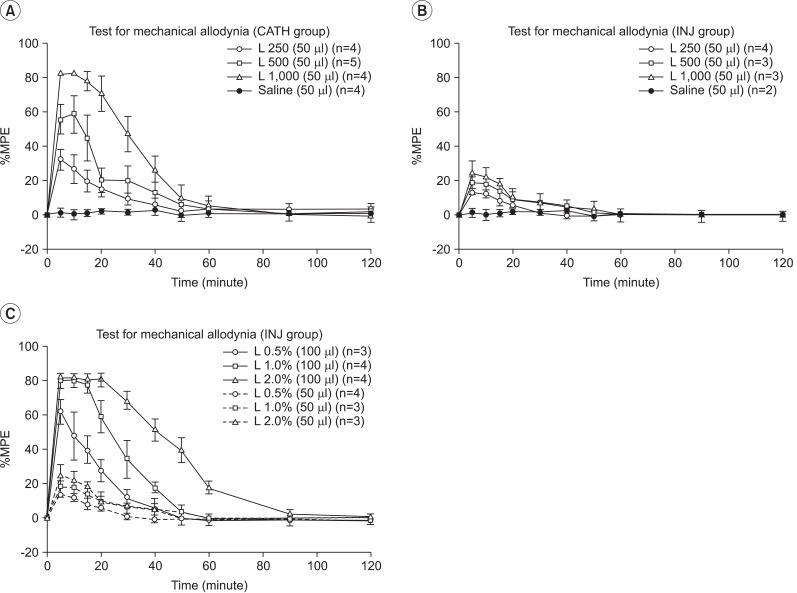Ann Rehabil Med.
2012 Oct;36(5):640-647.
Percutaneous Transforaminal Epidural Injection Method in an Experimental Rat: Minimally Invasive Drug Delivery Method to Spinal Epidural Space
- Affiliations
-
- 1Department of Physical Medicine & Rehabilitation, Gunsan Medical Center, Gunsan 573-713, Korea.
- 2Department of Physical Medicine & Rehabilitation, Korea University College of Medicine, Seoul 136-705, Korea. ljooll@korea.ac.kr
Abstract
OBJECTIVE
To compare a newly developed minimally-invasive method for percutaneous transforaminal epidural injection (INJ group) with the existing method for lumbar epidural catheterization (CATH group). METHOD: Through anatomical review of experimental rats, the cephalic one fourth of the neural foramen was selected as the target point for drug delivery. After the rats had undergone lumbar epidural catheterization, lidocaine, and 1% methylene blue were injected through the unilateral or bilateral L5/6 neural foramen in the INJ group, and through an epidural catheter in the CATH group. Measurement of body weight and the mechanical allodynia test before and after injection of lidocaine, and fine dissection after injection were performed.
RESULTS
Results of the mechanical allodynia test of 1.0% lidocaine 50 microl injection in the CATH group were statistically similar to those of 0.5% lidocaine 100 microl injection in the INJ group. The results of 2.0% lidocaine 50 microl injection in the CATH group were statistically similar to those of 1.0% lidocaine 100 microl injection in the INJ group. After dissection, only one distal partial spinal nerve was stained by methylene blue 50 microl through the transforaminal pathway. However, the dorsal root ganglion, nerve root, and adjacent hemi-partial spinal cord were stained by methylene blue 100 microl through the transforaminal pathway.
CONCLUSION
The percutaneous transforaminal epidural injection is practical, easy, and safe, and, in particular, does not cause significant pain compared to the existing lumbar epidural catheterization. We expect this method to be effective in an animal study showing that drug delivery to the spinal epidural space is necessary.
Keyword
MeSH Terms
Figure
Reference
-
1. van den Hoogen RH, Colpaert FC. Long term catheterization of the lumbar epidural space in rats. Pharmacol Biochem Behav. 1981; 15:515–516. PMID: 7291254.2. Chapman CR, Casey KL, Dubner R, Foley KM, Gracely RH, Reading AE. Pain measurement : an overview. Pain. 1985; 22:1–31. PMID: 4011282.3. Durant PA, Yaksh TL. Epidural injections of bupivacaine, morphine, fentanyl, lofentanil, and DADL in chronically implanted rats: a pharmacologic and pathologic study. Anesthesiology. 1986; 64:43–53. PMID: 2867721.4. Casey WF, Burnell JC. Nerve root irritation from an epidural catheter. Anaesthesia. 1982; 37:697–698. PMID: 7091632.
Article5. Chaplan SR, Bach FW, Pogrel JW, Chung JM, Yaksh TL. Quantitative assessment of tactile allodynia in the rat paw. J Neurosci Methods. 1994; 53:55–63. PMID: 7990513.
Article6. Xu JJ, Walla BC, Diaz MF, Fuller GN, Gutstein HB. Intermittent lumbar puncture in rats: a novel method for the experimental study of opioid tolerance. Anesth Analg. 2006; 103:714–720. PMID: 16931686.
Article7. Eckel TS, Bartynski WS. Epidural steroid injections and selective nerve root blocks. Tech Vasc Interv Radiol. 2009; 12:11–21. PMID: 19769903.
Article8. Du Pen SL, Peterson DG, Williams A, Bogosian AJ. Infection during chronic epidural catheterization: diagnosis and treatment. Anesthesiology. 1990; 73:905–909. PMID: 2240680.9. Kristensen JD, Post C, Gordh T Jr, Svensson BA. Spinal cord morphology and antinociception after chronic intrathecal administration of excitatory amino acid antagonists in the rat. Pain. 1993; 54:309–316. PMID: 8233545.
Article10. Tsang BK, He Z, Ma T, Ho IK, Eichhorn JH. Decreased paralysis and better motor coordination with microspinal versus PE10 intrathecal catheters in pain study rats. Anesth Analg. 1997; 84:591–594. PMID: 9052307.
Article11. Nagaro T. The histo-pathological changes in the epidural space and changes in the effect of anesthesia after long-term continuous epidural block. Masui. 1986; 35:227–235. PMID: 3702042.12. Giebler RM, Scherer RU, Peters J. Incidence of neurologic complications related to thoracic epidural catheterization. Anesthesiology. 1997; 86:55–63. PMID: 9009940.
Article13. Nishiyama T. A rat model of chronic lumbar epidural catheterization. Can J Anaesth. 1998; 45:907–912. PMID: 9818118.
- Full Text Links
- Actions
-
Cited
- CITED
-
- Close
- Share
- Similar articles
-
- Oblique interlaminar lumbar epidural steroid injection for management of low back pain with lumbosacral radicular pain: A case report
- Epidural Steroid Injection
- Epidural hematoma treated by aspiration after transforaminal epidural steroid injection - A case report -
- Analysis of Influencing Factors to Depth of Epidural Space for Lumbar Transforaminal Epidural Block in Korean
- Acute Cervical Subdural Hematoma with Quadriparesis after Cervical Transforaminal Epidural Block






